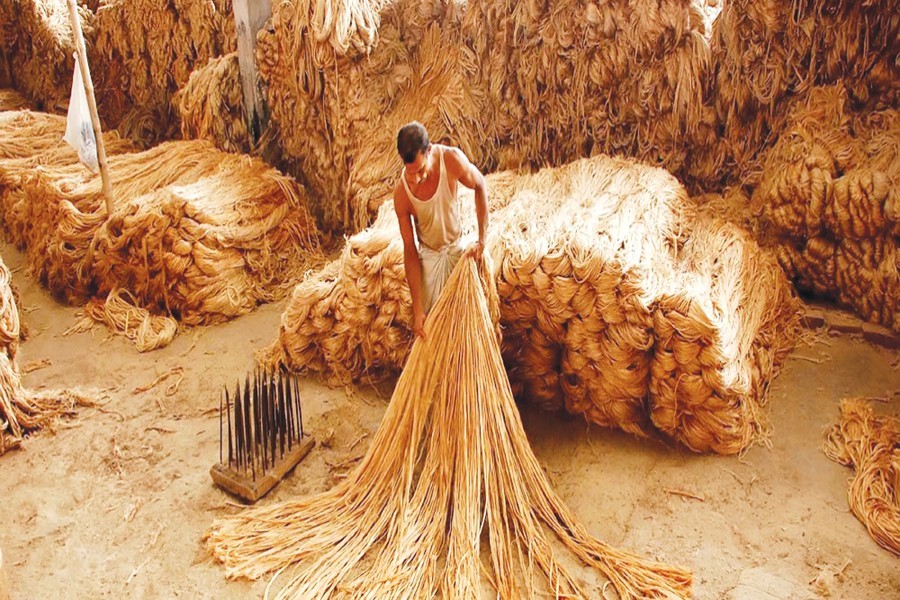In the last couple of decades, almost every year the pre-harvest period of jute accompanies a common mood among the farmers. They are happy about the bumper growth, and look forward to enjoying a profit bonanza from the sale of the crop. As days wear on, they become disillusioned. Come the harvest time, the upbeat mood of the farmers starts being overshadowed by misgivings. If a particular harvest season sees less than expected rainfall, retting of jute plants turns out to be a difficult job. With water bodies remaining largely dry, the harvested jute plants are left to wither way. The use of jute extraction machine and the retting of the fibre-plants in shallow ditches have yet to be in wide use. Following a flawed retting, the jute thus extracted proves to be of low quality. Due to being afflicted by nature's hostility, the jute growers are made to face a fall in the crop's price. In spite of all auspicious signs, poor market outlook deals a great blow to the farmers.
In fact, low market demand and a decline in price come up as the largest damper for the jute cultivators. About 15-20 years after the rejuvenation of jute cultivation in the country, the once-proverbial crop has yet to find a place among its major crops. But the crop was not supposed to meet this fate. True, after the global onslaught of polymer packaging and other products, export of jute had to suffer a miserable setback. In a span of over a decade, the famed 'golden fibre' of Bangladesh fell on bad times. As years rolled by, the polymer or polythene products only became more sleek, tempting and user-friendly. In spite of the outcry worldwide over the deleterious impact of the synthetic polymer residue on the environment, factories continued churning out the products. With the global production of plastic and polythene-made consumer items increasing, the jute exports continued to decline. As corollary, the country's jute fields kept shrinking unabated. The last nail in the coffin of jute was driven with the farmers switching over to other crops. Before the recent resurgence in jute farming, the crop veritably became a thing of the past.
Jute had once been the only foreign exchange-earner of Bangladesh. After the eventual dying out of jute in agriculture, Bangladesh struggled a lot to announce its presence in international trade. It was by a sheer stroke of luck that the jute sector began entering the national spotlight -- and showing export prospects, alongside the spurt in the ready-made garment (RMG) exports.
In the recent predictions of environmental scientists about the fallout of the wide use of polythene goods, Bangladesh had read the signs of a rebirth of jute. Apart from encouragement offered to farmers to resume jute cultivation, fresh opportunities opened before them for greater market access. Most of these prospects and initiatives finally petered out leaving the jute cultivators baffled and dejected. In the long run, the seemingly resuscitated jute sector of the country was found mired in a web of uncertainties.
Pessimists at times feel like dismissing all these high hopes and production-related fillips as being banal exercises. Many would call them mere sops. A few of the disgruntled groups may draw the conclusion that the death-knell to jute has already started ringing, and also that jute's full revival is a virtual chimera. They have potent reasons for these words of doom for jute -- the most conveniently procurable natural fibrous substance. Their fear brings into focus the global network of plastic producers. The adverse environmental impact of plastic doesn't distress them. Nor do they have much worry over the socio-economic redundancy facing the farmers in the jute-growing countries. Alarming news fills the air. It is centred on the seemingly invincible global industrial syndicate involved in spreading polythene products throughout the length and breadth of vulnerable countries. That it will eventually end in a widespread catastrophe, as feared by environmental experts, did not surface distinctively. In a situation like this, Bangladesh has been found witnessing helplessly how its once-unassailable global jute market slipping out of its grip. Concomitantly, the jute fields continued to get squeezed.
Nevertheless, Bangladesh has been able to chart out its own way out. The event of jute plant genome decoding by the country's researchers in 2010 was hailed as a watershed. It heralded the opening of a new era in the country's jute sector. For it made a complete break with the country's jute cultivation in the past. In place of the traditionally cultivated short and shallow jute plants, the scientists discovered a completely new jute plant variety. The fibre extracted from this new jute plant proved better in quality. It took only seven years for a Bangladesh scientist to invent a type of polymer from jute. Products made of this invention would be highly biodegradable, claimed the scientist. This is a national misfortune, and also a failure of massive proportions, that the country has yet to put to practical and fruitful use its breakthrough discoveries involving jute.
That tracts of jute fields continue to expand in the country is no big news. Nor is the fact that price of jute is on the increase and the government considers stricter laws on compulsory use of jute in packaging. The leitmotif being the revival of jute's glory days, its place in the world market has to be ensured first. Time is running out.


